2018 NISSAN 370Z COUPE wheel
[x] Cancel search: wheelPage 406 of 453

9-6Maintenance and schedules
Engine oil and oil filter:
Replace engine oil and oil filter at the
specified intervals. For recommended oil
grade and viscosity refer to “Capacities
and recommended fluids/lubricants”
(P.10-2).
Evaporative Emissions Control Vapor
Lines*:
Check vapor lines for leaks or looseness.
Tighten connections or replace parts as
necessary.
Fuel lines*:
Check the fuel hoses, piping and connec-
tions for leaks, looseness, or deterioration.
Tighten connections or replace parts as
necessary.
Spark plugs:
Replace at specified intervals. Install new
plugs of the type as originally equipped.
CHASSIS AND BODY MAINTENANCE
Brake lines and cables:
Visually inspect for proper installation.
Check for chafing, cracks, deterioration,
and signs of leaking. Replace any deterio-
rated or damaged parts immediately.
Brake pads and rotors:
Check for wear, deterioration and fluid
leaks. Replace any deteriorated or da-
maged parts immediately.Exhaust system:
Visually inspect the exhaust pipes, muffler
and hangers for leaks, cracks, deteriora-
tion, and damage. Tighten connections or
replace parts as necessary.
In-cabin microfilter:
Replace at specified intervals. When driv-
ing for prolonged periods in dusty condi-
tions, replace the filter more frequently.
Steering gear and linkage, axle and
suspension parts:
Check for damage, looseness, and leak-
age of oil or grease. Under severe driving
conditions, inspect more frequently.
Tire rotation:
Tires cannot be rotated, as the front tires
are a different size from the rear tires and
the direction of wheel rotation is fixed in
each tire.
Transmission fluid/oil, differential oil:
Visually inspect for signs of leakage at
specified intervals.
To help ensure smooth, safe and eco-
nomical driving, NISSAN provides two
maintenance schedules that may be
used, depending upon the conditions in
which you usually drive. These schedules
contain both distance and time intervals,
up to 120,000 miles (192,000 km)/144
months. For most people, the odometer
reading will indicate when service is
needed. However, if you drive very little,
your vehicle should be serviced at the
regular time intervals shown in the sche-
dule.
After 120,000 miles (192,000 km)/144
months, continue maintenance at the
same mileage/time intervals.
ADDITIONAL MAINTENANCE ITEMS
FOR SEVERE OPERATING CONDI-
TIONS
Additional maintenance items for se-
vere operating conditions;
should be
performed on vehicles that are driven
under especially demanding conditions.
Additional maintenance items should be
performed if you primarily operate your
vehicle under the following conditions:
. Repeated short trips of less than 5
miles (8 km).
. Repeated short trips of less than 10
miles (16 km) with outside tempera-
tures remaining below freezing.
MAINTENANCE SCHEDULES
Page 419 of 453

10 Technical and consumer information
Capacities and
recommended fluids/lubricants ...................................... 10-2Fuel information .................................................................... 10-4
Engine oil and oil filter recommendation .......... 10-7
Air conditioning system refrigerant and
lubricant recommendations ....................................... 10-8
Specifications ........................................................................\
.......... 10-9 Engine ........................................................................\
.................... 10-9
Wheels and tires ................................................................. 10-10
Dimensions ........................................................................\
....... 10-11
When traveling or registering in
another country ........................................................................\
. 10-12
Vehicle identification .............................................................. 10-12 Vehicle Identification Number (VIN) plate ....... 10-12
Vehicle identification number
(chassis number) ................................................................. 10-12
Engine serial number ....................................................... 10-13
F.M.V.S.S./C.M.V.S.S. certification label ................. 10-13
Emission control information label ...................... 10-13
Tire and Loading Information label ..................... 10-14
Air conditioner specification label ......................... 10-14
Installing front license plate ............................................. 10-15 Except for NISMO models ............................................ 10-15
For NISMO models ............................................................. 10-17 Removing air deflectors (except for
NISMO models) ........................................................................\
.... 10-18
Vehicle loading information ............................................. 10-19
Terms ........................................................................\
................. 10-19
Vehicle load capacity .................................................. 10-20
Loading tips ........................................................................\
.. 10-21
Measurement of weights ........................................... 10-21
Towing a trailer ........................................................................\
. 10-22
Flat towing ........................................................................\
............ 10-22 Automatic transmission ............................................. 10-22
Manual transmission .................................................... 10-22
Uniform tire quality grading ........................................... 10-23 Treadwear ........................................................................\
..... 10-23
Traction AA, A, B and C .............................................. 10-23
Temperature A, B and C ............................................ 10-23
Emission control system warranty ............................ 10-24
Reporting safety defects ................................................... 10-24
Readiness for Inspection/Maintenance
(I/M) test ........................................................................\
.................. 10-25
Event Data Recorders (EDR) ............................................ 10-25
Owner’s Manual/Service Manual
order information .................................................................... 10-26
Page 428 of 453
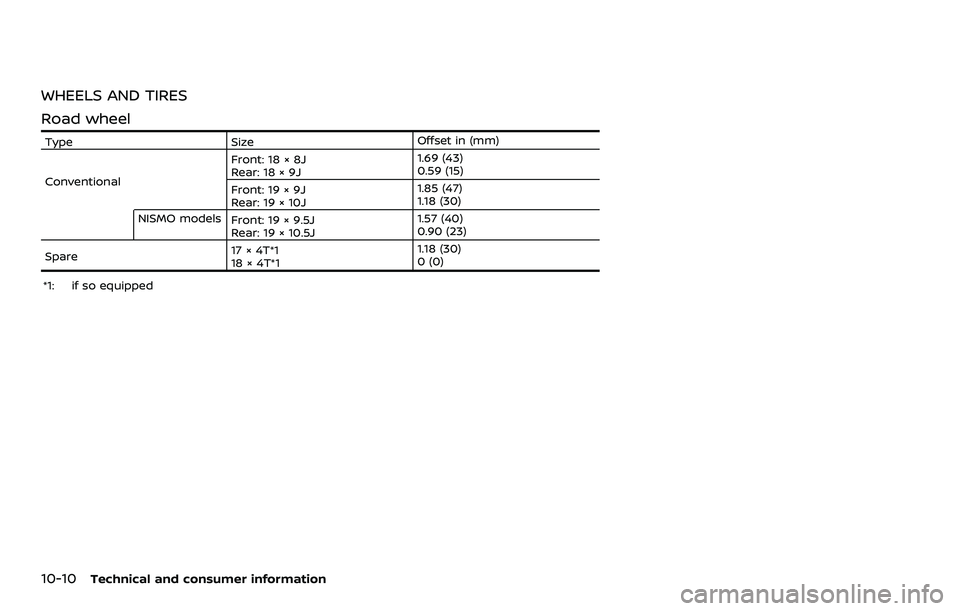
10-10Technical and consumer information
WHEELS AND TIRES
Road wheel
TypeSize Offset in (mm)
Conventional Front: 18 × 8J
Rear: 18 × 9J
1.69 (43)
0.59 (15)
Front: 19 × 9J
Rear: 19 × 10J 1.85 (47)
1.18 (30)
NISMO models Front: 19 × 9.5J
Rear: 19 × 10.5J 1.57 (40)
0.90 (23)
Spare 17 × 4T*1
18 × 4T*1 1.18 (30)
0 (0)
*1: if so equipped
Page 429 of 453
![NISSAN 370Z COUPE 2018 Owners Manual Tire
TypeSize Pressure PSI (kPa) [Cold]
Conventional Front: 225/50R18 95W
Rear: 245/45R18 96W
35 (240)*2
38 (260)*3
Front: 245/40R19 94W
Rear: 275/35R19 96W 32 (220)
NISMO models Front: 245/40R19 98Y
NISSAN 370Z COUPE 2018 Owners Manual Tire
TypeSize Pressure PSI (kPa) [Cold]
Conventional Front: 225/50R18 95W
Rear: 245/45R18 96W
35 (240)*2
38 (260)*3
Front: 245/40R19 94W
Rear: 275/35R19 96W 32 (220)
NISMO models Front: 245/40R19 98Y](/manual-img/5/58160/w960_58160-428.png)
Tire
TypeSize Pressure PSI (kPa) [Cold]
Conventional Front: 225/50R18 95W
Rear: 245/45R18 96W
35 (240)*2
38 (260)*3
Front: 245/40R19 94W
Rear: 275/35R19 96W 32 (220)
NISMO models Front: 245/40R19 98Y
Rear: 285/35R19 99Y 35 (240)
Spare (T-type) T145/80D17 107M*1
T145/70R18 107M*1
60 (420)
—*3, *4
*1: if so equipped
*2: Coupe models
*3: Roadster models
*4: The emergency tire puncture repair kit is supplied.
DIMENSIONS
in (mm)
Overall length 167.6 (4,255)*1 167.7 (4,260)*2
170.5 (4,330)*3
Overall width 72.6 (1,845) 73.6 (1,870)*3
Overall height 51.8 (1,315) 52.2 (1,325)*4
Front tread 61.0 (1,550)*5 60.6 (1,540)*6
61.2 (1,555)*6, *3
Rear tread 62.8 (1,595)*5
61.6 (1,565)*6
62.2 (1,580)*6, *3
Wheelbase 100.4 (2,550)
*1: Without front license plate bracket
*2: With front license plate bracket
*3: NISMO models
*4: Roadster models
*5: 18-inch wheel models
*6: 19-inch wheel models
Technical and consumer information10-11
Page 436 of 453
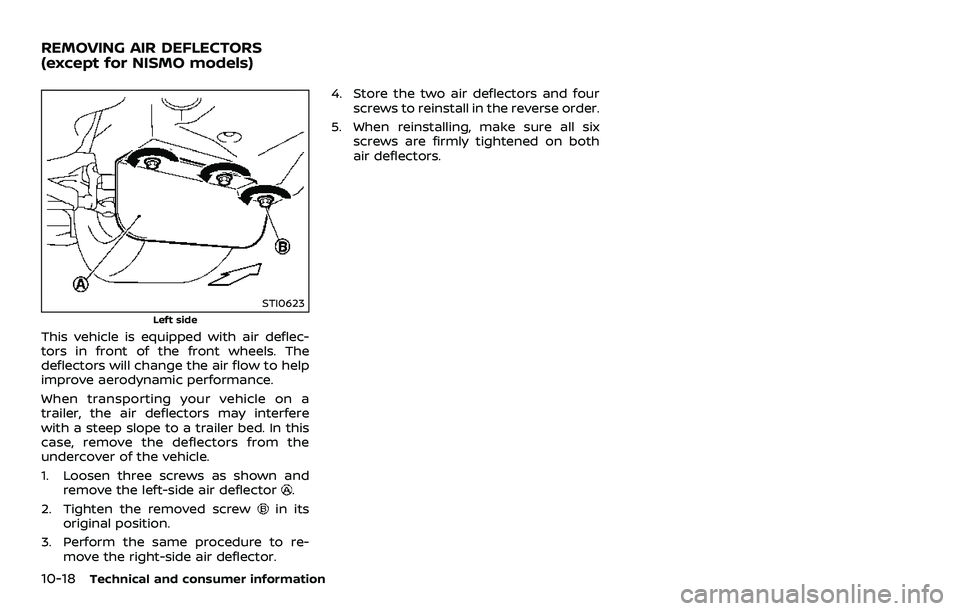
10-18Technical and consumer information
STI0623
Left side
This vehicle is equipped with air deflec-
tors in front of the front wheels. The
deflectors will change the air flow to help
improve aerodynamic performance.
When transporting your vehicle on a
trailer, the air deflectors may interfere
with a steep slope to a trailer bed. In this
case, remove the deflectors from the
undercover of the vehicle.
1. Loosen three screws as shown andremove the left-side air deflector
.
2. Tighten the removed screw
in its
original position.
3. Perform the same procedure to re- move the right-side air deflector. 4. Store the two air deflectors and four
screws to reinstall in the reverse order.
5. When reinstalling, make sure all six screws are firmly tightened on both
air deflectors.
REMOVING AIR DEFLECTORS
(except for NISMO models)
Page 439 of 453
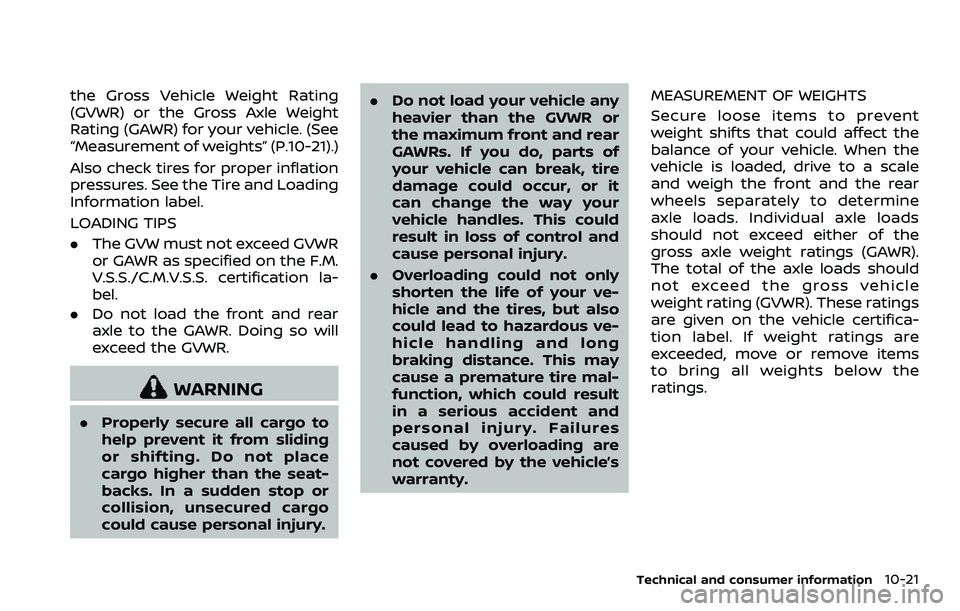
the Gross Vehicle Weight Rating
(GVWR) or the Gross Axle Weight
Rating (GAWR) for your vehicle. (See
“Measurement of weights” (P.10-21).)
Also check tires for proper inflation
pressures. See the Tire and Loading
Information label.
LOADING TIPS
.The GVW must not exceed GVWR
or GAWR as specified on the F.M.
V.S.S./C.M.V.S.S. certification la-
bel.
. Do not load the front and rear
axle to the GAWR. Doing so will
exceed the GVWR.
WARNING
.Properly secure all cargo to
help prevent it from sliding
or shifting. Do not place
cargo higher than the seat-
backs. In a sudden stop or
collision, unsecured cargo
could cause personal injury. .
Do not load your vehicle any
heavier than the GVWR or
the maximum front and rear
GAWRs. If you do, parts of
your vehicle can break, tire
damage could occur, or it
can change the way your
vehicle handles. This could
result in loss of control and
cause personal injury.
. Overloading could not only
shorten the life of your ve-
hicle and the tires, but also
could lead to hazardous ve-
hicle handling and long
braking distance. This may
cause a premature tire mal-
function, which could result
in a serious accident and
personal injury. Failures
caused by overloading are
not covered by the vehicle’s
warranty. MEASUREMENT OF WEIGHTS
Secure loose items to prevent
weight shifts that could affect the
balance of your vehicle. When the
vehicle is loaded, drive to a scale
and weigh the front and the rear
wheels separately to determine
axle loads. Individual axle loads
should not exceed either of the
gross axle weight ratings (GAWR).
The total of the axle loads should
not exceed the gross vehicle
weight rating (GVWR). These ratings
are given on the vehicle certifica-
tion label. If weight ratings are
exceeded, move or remove items
to bring all weights below the
ratings.
Technical and consumer information10-21
Page 440 of 453
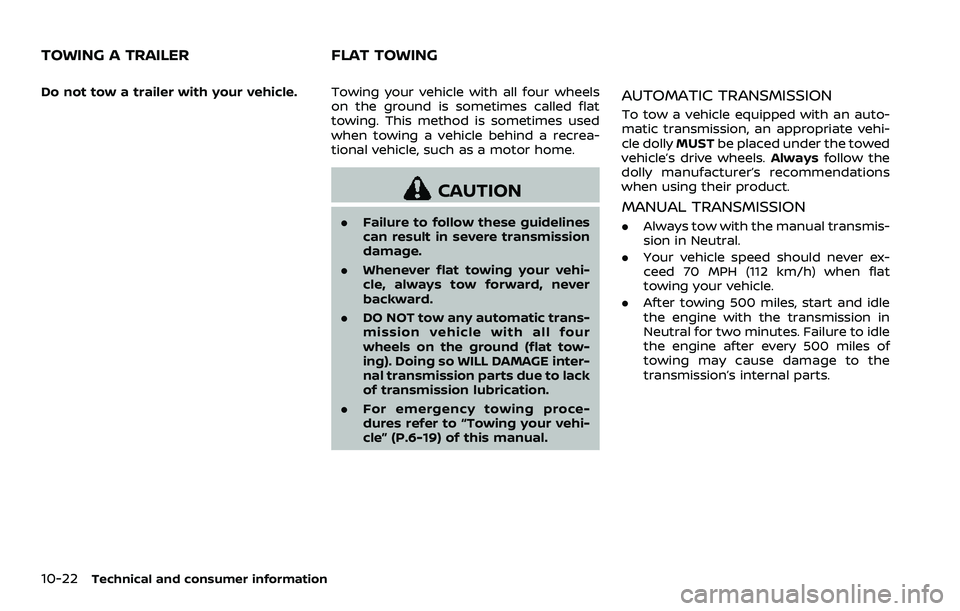
10-22Technical and consumer information
Do not tow a trailer with your vehicle.Towing your vehicle with all four wheels
on the ground is sometimes called flat
towing. This method is sometimes used
when towing a vehicle behind a recrea-
tional vehicle, such as a motor home.
CAUTION
.Failure to follow these guidelines
can result in severe transmission
damage.
. Whenever flat towing your vehi-
cle, always tow forward, never
backward.
. DO NOT tow any automatic trans-
mission vehicle with all four
wheels on the ground (flat tow-
ing). Doing so WILL DAMAGE inter-
nal transmission parts due to lack
of transmission lubrication.
. For emergency towing proce-
dures refer to “Towing your vehi-
cle” (P.6-19) of this manual.
AUTOMATIC TRANSMISSION
To tow a vehicle equipped with an auto-
matic transmission, an appropriate vehi-
cle dolly MUSTbe placed under the towed
vehicle’s drive wheels. Alwaysfollow the
dolly manufacturer’s recommendations
when using their product.
MANUAL TRANSMISSION
. Always tow with the manual transmis-
sion in Neutral.
. Your vehicle speed should never ex-
ceed 70 MPH (112 km/h) when flat
towing your vehicle.
. After towing 500 miles, start and idle
the engine with the transmission in
Neutral for two minutes. Failure to idle
the engine after every 500 miles of
towing may cause damage to the
transmission’s internal parts.
TOWING A TRAILER FLAT TOWING
Page 441 of 453
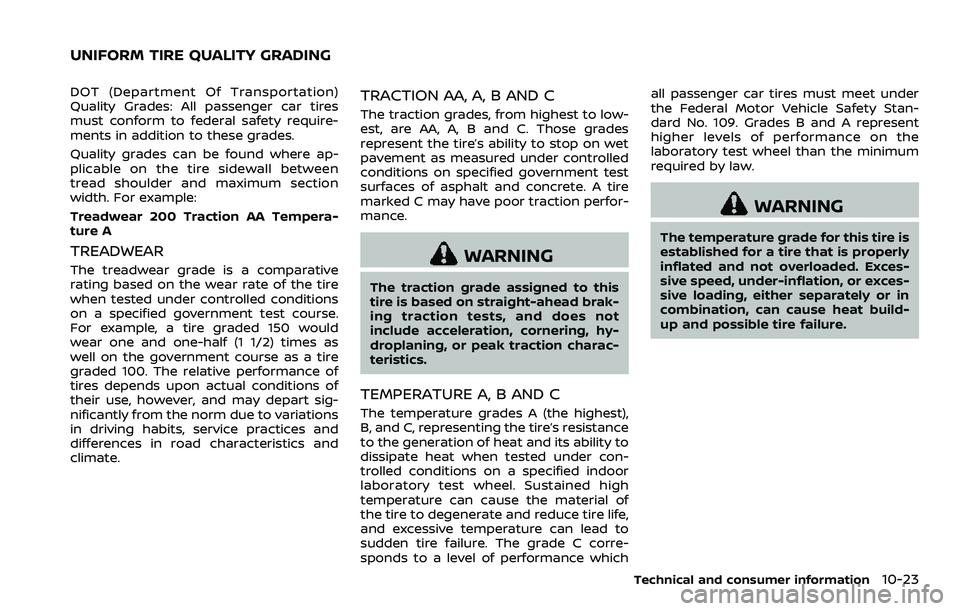
DOT (Department Of Transportation)
Quality Grades: All passenger car tires
must conform to federal safety require-
ments in addition to these grades.
Quality grades can be found where ap-
plicable on the tire sidewall between
tread shoulder and maximum section
width. For example:
Treadwear 200 Traction AA Tempera-
ture A
TREADWEAR
The treadwear grade is a comparative
rating based on the wear rate of the tire
when tested under controlled conditions
on a specified government test course.
For example, a tire graded 150 would
wear one and one-half (1 1/2) times as
well on the government course as a tire
graded 100. The relative performance of
tires depends upon actual conditions of
their use, however, and may depart sig-
nificantly from the norm due to variations
in driving habits, service practices and
differences in road characteristics and
climate.
TRACTION AA, A, B AND C
The traction grades, from highest to low-
est, are AA, A, B and C. Those grades
represent the tire’s ability to stop on wet
pavement as measured under controlled
conditions on specified government test
surfaces of asphalt and concrete. A tire
marked C may have poor traction perfor-
mance.
WARNING
The traction grade assigned to this
tire is based on straight-ahead brak-
ing traction tests, and does not
include acceleration, cornering, hy-
droplaning, or peak traction charac-
teristics.
TEMPERATURE A, B AND C
The temperature grades A (the highest),
B, and C, representing the tire’s resistance
to the generation of heat and its ability to
dissipate heat when tested under con-
trolled conditions on a specified indoor
laboratory test wheel. Sustained high
temperature can cause the material of
the tire to degenerate and reduce tire life,
and excessive temperature can lead to
sudden tire failure. The grade C corre-
sponds to a level of performance whichall passenger car tires must meet under
the Federal Motor Vehicle Safety Stan-
dard No. 109. Grades B and A represent
higher levels of performance on the
laboratory test wheel than the minimum
required by law.
WARNING
The temperature grade for this tire is
established for a tire that is properly
inflated and not overloaded. Exces-
sive speed, under-inflation, or exces-
sive loading, either separately or in
combination, can cause heat build-
up and possible tire failure.
Technical and consumer information10-23
UNIFORM TIRE QUALITY GRADING